
The Globally Harmonized System (GHS) for the classification and labelling of chemicals was introduced to ensure the safe handling of hazardous substances worldwide.[1]
It ensures that hazardous substances are classified internationally in a uniform manner and labeled with clear GHS pictograms.
In the European Union, the implementation of the GHS is legally regulated by the CLP Regulation (EC) No. 1272/2008 [2].
GHS labeling allows companies, employees and consumers to identify the risks posed by a substance at a glance. Each GHS symbol stands for a specific hazard class, such as flammability, toxicity or environmental hazard. This clear labeling is a central component of hazardous substance management and helps to prevent accidents at work and health risks.
What do the GHS symbols mean?
The GHS symbols are internationally standardized hazard pictograms that are used on packaging, safety data sheets and lists of hazardous substances are to be found. They provide information at a glance about the risks posed by a substance or mixture.
GHS pictograms are eye-catching symbols with a red frame, black symbol on a white background and ensure clear labeling of hazardous substances. There are a total of nine different GHS pictograms, each of which stands for a specific hazard class. These hazard pictograms are particularly important for companies as they help to identify safety measures at an early stage and implement them correctly.
Why are GHS pictograms so important?
✔ Uniform and clear labeling of hazardous chemicals
✔ Easy to understand for employees in industry and trade
✔ Meets legal requirements for the safe handling of hazardous substances
✔ Helps with the correct storage and use of chemicals
In the following section you will find a detailed overview of the GHS pictograms, in which the meaning of the GHS symbols and their hazard classes are explained. We also explain which H-phrases (hazard statements) belong to the respective substances and how companies can implement the correct labeling.
How to recognize hazardous substances – The
GHS pictograms and their meaning

GHS01 – Exploding bomb
Hazard classes: Explosive substances and mixtures; Self-reactive substances and mixtures; Organic peroxides
H-phrases / appropriate hazard class
H200, H201, H203, H204 / Explosive substances/mixtures, products containing explosive substances (unstable)
H240, H241 / Self-reactive substances/mixtures
H240, H241 / Organic peroxides 🠖 Substances which may explode/self-decompose easily
What does that mean?
This symbol warns of chemicals that can explode under certain conditions, for example due to heat, friction or impact. These substances are particularly dangerous during transportation and storage
Examples: Certain peroxides in paints and coatings, spray cans with propellants, certain adhesives and sealants
Safety precautions:
✔ Store in a cool, dry place away from sources of ignition
✔ Use explosion-proof tools
✔ Do not rub, press or knock

GHS02 – Flame
Hazard classes: Flammable gases, liquids, aerosols and solids; Self-reactive substances/mixtures; Self-heating substances/mixtures; Organic peroxides; Desensitized explosive substances/mixtures, Pyrophoric gases, liquids or solids
H-phrases / appropriate hazard class
H220, H221 / Extremely flammable gas
H220, H230, H231 / Chemically unstable gases 🠖 May decompose or react spontaneously
H222, H223, H229 / Extremely flammable aerosols
H224, H225, H226 / Flammable liquids
H228 / Flammable solids
H241, H242 / Self-reactive substances/mixtures
H220, H232 /Pyrophoricgases 🠖 Ignite on contact with air
H250 / Pyrophoric liquids and solids 🠖 Ignite on contact with air
H228 / Flammable solids
H251, H252 / Self-heating substances/mixtures
H260, H261 / Substances/mixtures which, in contact with water, emit flammable gases
H241, H242 / Organic peroxides 🠖 Sensitive, explosive or self-reactive.
H206, H207, H208 / Desensitized explosive substances/mixtures 🠖 Attenuated explosives
What does that mean?
This pictogram indicates substances that can easily ignite – for example through sparks, open flames or high temperatures.
Examples: Gasoline, brake cleaner, thinner, solvent-based paints, spray adhesive
Safety precautions:
✔ Fireproof storage, keep away from heat sources
✔ Avoid sparks and open flames
✔ Keep container tightly closed

GHS03 – Flame above a circle
Hazard classes: Oxidizing gases, liquids and solids
H-phrases / appropriate hazard class
H270/ Oxidizing gases 🠖 Promotes fires by releasing oxygen.
H271, H272 / Oxidizing liquids 🠖 Promotes fires by releasing oxygen.
H271, H272 / Oxidizing solids 🠖 Promotes fires by releasing oxygen.
What does that mean?
These chemicals themselves are not necessarily flammable, but can intensify fires or make them more difficult to extinguish. They provide additional oxygen and are therefore particularly dangerous.
Examples: Oxygen cylinders, hydrogen peroxide as a bleaching agent
Safety precautions:
✔ Store away from flammable materials
✔ No direct contact with flammable materials
✔ Keep away from heat and flames

GSH04 – Gas cylinder
Hazard class: Gases under pressure
H-phrases / appropriate hazard class
H280, H280 / gases under pressure: compressed/liquefied/refrigerated liquefied/dissolved
What does that mean?
Under unfavorable conditions, gases in pressurized cylinders can burst or – in the case of cryogenic gases – cause cold burns.
Examples: Acetylene and oxygen cylinders, carbon dioxide cylinders (fire extinguishers)
Safety precautions:
✔ Wear protective gloves & goggles for cryogenic gases
✔ Do not heat
✔ Store upright and secured

GHS05 – Corrosivity
Hazard classes: Skin corrosion/irritation; Serious eye damage/eye irritation; Corrosive to metals
H-phrases / appropriate hazard class
H290/ Corrosive to metals 🠖 Destroys or weakens metals
H314/ Skin irritation/corrosion
H318/ Serious eye damage/irritation
What does that mean?
These chemicals can severely corrode the skin and eyes and attack materials such as metal.
Examples: Battery acid, pickling and etching agents, strongly alkaline or acidic cleaning agents (e.g. drain cleaners)
Safety precautions:
✔ Avoid contact (wear safety goggles, gloves)
✔ Provide emergency shower, eyewash station
✔ Do not mix with water (risk of reaction)

GHS06 – Skull with crossed bones
Hazard classes: Acute toxicity oral, dermal and inhalation
H-phrases / appropriate hazard class
H300, H301, H310, H311, H330, H331: Acute toxicity 🠖 Even the smallest quantities are toxic.
What does that mean?
Even small amounts can be toxic or fatal – through inhalation, skin contact or ingestion.
Examples: Certain hardeners for paints and resins, highly toxic electroplating chemicals, toxic pesticides
Safety precautions:
✔ Do not touch, inhale or swallow
✔ Store in an airtight container, ensure extraction
✔ Never release into the environment

GHS07 – Exclamation mark
Hazard classes: Acute toxicity; Skin irritation; Eye irritation; Skin sensitization; Specific target organ toxicity (single exposure); Aspiration hazard
H-phrases / appropriate hazard class
H302, H312, H332 / acute toxicity 🠖 Even the smallest amounts are toxic.
H315 / Irritant effect on the skin
H319 / Serious eye damage/irritation
H317 / Skin sensitization 🠖 May cause (long-term) skin allergy
H335, H336 / Specific target organ toxicity (single exposure) 🠖 harms specific organs
H420 / Harmful to the ozone layer
What does that mean?
These substances are not necessarily fatal, but can cause skin irritation, allergic reactions or respiratory problems.
Examples: Solvent-based paints and thinners, cooling lubricants and oils, glass and sanitary cleaners
Safety precautions:
✔ Avoid contact with skin and eyes
(wear protective gloves & goggles)
✔ Do not inhale or swallow
✔ Use well-ventilated work areas

GHS08 – Health hazard
Hazard classes: Carcinogenicity; Germ cell mutagenicity; Reproductive toxicity; Specific target organ toxicity (repeated exposure); Aspiration hazard
H-phrases / appropriate hazard class
H334 / Respiratory sensitization 🠖 May cause respiratory allergies or asthma
H340, H341 / Germ cell mutagenicity 🠖 May cause genetic defects
H350, H351 / Carcinogenic effect 🠖 May cause cancer
H360, H361 / Reproductive toxicity 🠖 May damage fertility / the unborn child
H370, H371 / Specific target organ toxicity (single exposure) 🠖 harms specific organs
H372, H373 / Specific target organ toxicity (repeated exposure) 🠖 harms specific organs
H304 / Aspiration hazard 🠖 May get into the lungs and cause serious breathing difficulties
What does that mean?
These substances can cause long-term damage to health, for example through regular contact or inhalation.
Examples: Waste oil, benzene vapors, certain wood preservatives
Safety precautions:
✔ Obtain information about the hazardous substance
✔ Keep exposure as low as possible
✔ Wear protective equipment
(gloves, eye and mouth protection / respiratory protection)

GHS09 – Environmental hazard
Hazard class: Hazardous to the aquatic environment
H-phrases / appropriate hazard class
H400/ acute 🠖 Very toxic to aquatic life
H410, 411 / chronic 🠖 Very toxic to aquatic life with long lasting effects
What does that mean?
These chemicals are toxic to aquatic organisms and can cause long-term environmental damage.
Examples: Used oil, brake fluid, paints and varnishes containing solvents, pesticides, disinfectants
Safety precautions:
✔ Do not discharge into waste water or soil
✔ Dispose of in hazardous waste only
✔ Observe environmental regulations
GHS labeling in practice: How to implement the requirements correctly
The GHS pictograms make it easier to identify hazardous substances, but legally compliant implementation in the workplace requires more than just correct labeling.
How do you ensure that your company meets all legal requirements and handles hazardous substances safely?
In addition to correct labeling, clear measures are crucial for the safe handling of hazardous substances. From correct storage and employee training to digital documentation digital documentation there are many factors that companies need to consider.
Professional references & references
[2]

Free GHS guide for your company
Get a compact overview of all GHS hazard classes with pictograms and H-phrases – clearly explained and supplemented by practical tips for implementation in your company.
✔ Ideal for training, as a reference book or for displaying in the warehouse
✔ Includes tips on correct labeling & storage
✔ Can be perfectly combined with the use of SDBcheck®
Printing tip: Use in portrait format with 2 pages per sheet or stapled in landscape format – for maximum clarity in everyday life.
Act now: Digital hazardous substance management with SDBcheck®
A legally compliant hazardous substance management does not have to be complicated or time-consuming. SDBcheck® helps you to implement all GHS requirements efficiently:
✔ Manage hazardous substances digitally – put an end to confusing Excel lists
✔ Safety data sheets always to hand – automatic updates and structured filing
✔ Meet legal requirements – ISO 14001 and 9001 compliant hazardous substances register easy to manage
✔ Protection for your team – keep employees informed at all times and ensure safety
➜ Use SDBcheck® now for simple, digital hazardous substance management!
Visit our webinar

Are you responsible for managing hazardous substances and struggling with confusing Excel lists? Are you missing a simple, digital solution to efficiently maintain your hazardous substances register and keep it up to date?
What you can expect:
✔ Legal basics explained clearly – what is really important
✔ Automated reading of safety data sheets – save time instead of typing
✔ Why a software solution is superior to Excel – efficiency, safety & transparency ✔ Step-by-step to digital hazardous substance management – from recording to release ✔ Simple updating & management – always up to date Transparency
✔ Step-by-step to digital hazardous substance management – from recording to release
✔ Easy updating & management – always up to date
✔ Safe release of hazardous substance information for employees – targeted & structured











